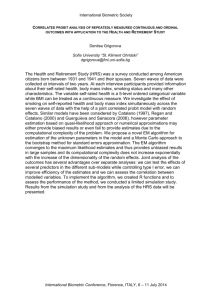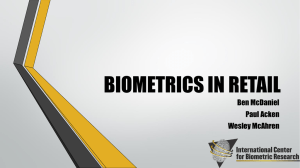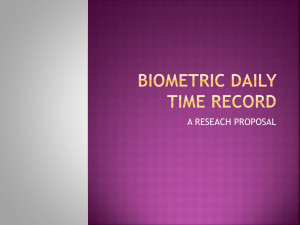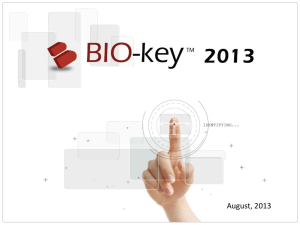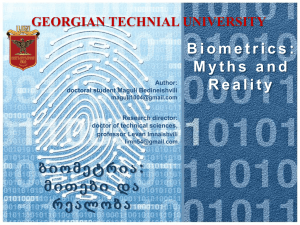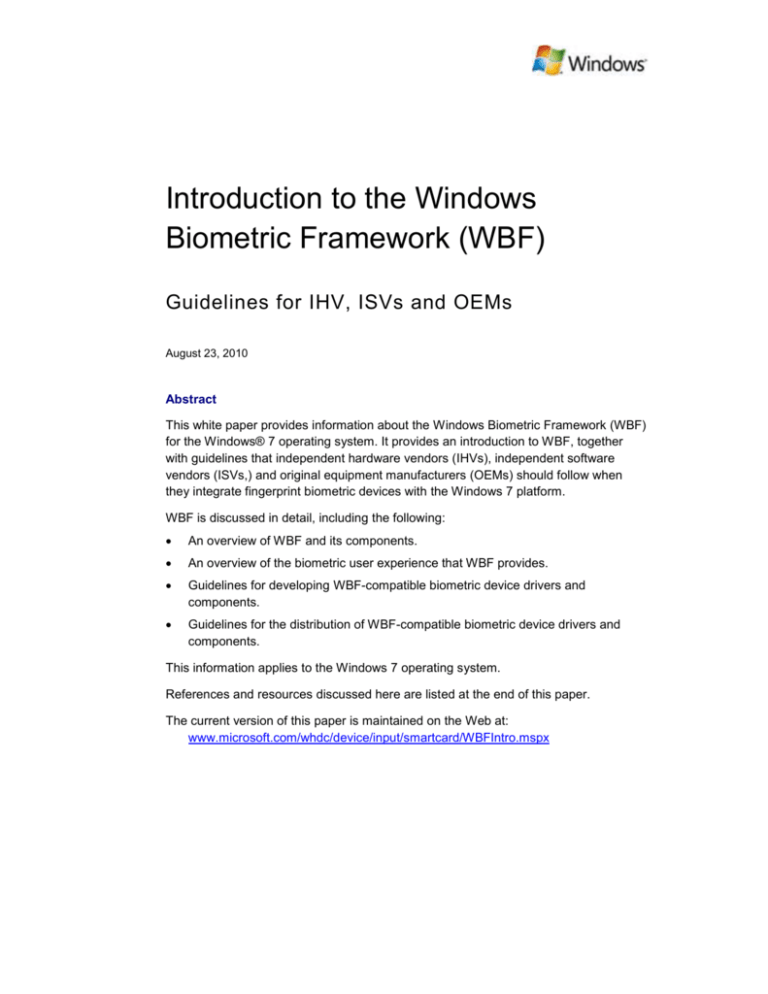
Introduction to the Windows
Biometric Framework (WBF)
Guidelines for IHV, ISVs and OEMs
August 23, 2010
Abstract
This white paper provides information about the Windows Biometric Framework (WBF)
for the Windows® 7 operating system. It provides an introduction to WBF, together
with guidelines that independent hardware vendors (IHVs), independent software
vendors (ISVs,) and original equipment manufacturers (OEMs) should follow when
they integrate fingerprint biometric devices with the Windows 7 platform.
WBF is discussed in detail, including the following:
An overview of WBF and its components.
An overview of the biometric user experience that WBF provides.
Guidelines for developing WBF-compatible biometric device drivers and
components.
Guidelines for the distribution of WBF-compatible biometric device drivers and
components.
This information applies to the Windows 7 operating system.
References and resources discussed here are listed at the end of this paper.
The current version of this paper is maintained on the Web at:
www.microsoft.com/whdc/device/input/smartcard/WBFIntro.mspx
Introduction to the Windows Biometric Framework - 2
Disclaimer: This document is provided “as-is”. Information and views expressed in this document, including
URL and other Internet Web site references, may change without notice. You bear the risk of using it.
This document does not provide you with any legal rights to any intellectual property in any Microsoft
product. You may copy and use this document for your internal, reference purposes.
© 2010 Microsoft Corporation. All rights reserved.
Document History
Date
Change
August 23, 2010
Corrected hyperlinks in “Resources” section.
March 17, 2009
Corrected typo in Figure 1: changed “Foundation” to
“Framework”.
December 15, 2008
First publication
Contents
Introduction ..................................................................................................................... 4
Terminology and Definitions ........................................................................................... 4
Windows Biometric Framework Overview .......................................................................... 5
WBF Core Platform ........................................................................................................... 5
Windows Biometric Driver Interface (WBDI) ................................................................... 6
Windows Biometric Service (WBS) ................................................................................. 7
WBF API ....................................................................................................................... 9
WBF User Experience ........................................................................................................ 9
Discovery Points ........................................................................................................... 9
Application Start Points ............................................................................................. 10
Management Capabilities ............................................................................................ 10
Supported Scenarios ................................................................................................... 10
WBF Management .......................................................................................................... 10
Biometric Device Control Panel .................................................................................... 10
Biometric System Management ................................................................................... 11
WBF Driver and Component Distribution .......................................................................... 11
Summary ........................................................................................................................ 12
August 23, 2010
© 2010 Microsoft Corporation. All rights reserved.
Introduction to the Windows Biometric Framework - 3
Resources ....................................................................................................................... 12
August 23, 2010
© 2010 Microsoft Corporation. All rights reserved.
Introduction to the Windows Biometric Framework - 4
Introduction
Biometrics is an increasingly popular technology that provides convenient access to
systems, services, and resources. Biometrics relies on measuring an unchanging
physical characteristic of a person to uniquely identify that person. Fingerprints are
one of the most frequently used biometric characteristics, with millions of fingerprint
biometric devices that are embedded in personal computers and peripherals.
In Windows® 7, the Windows Biometric Framework (WBF) provides support for
fingerprint biometric devices through a new set of components. These components
improve the quality, reliability, and consistency of the user experience for customers
who have fingerprint biometric devices.
This white paper gives a high-level overview of WBF and its components, including the
WBF core architecture, user experience and manageability features, and supported
distribution mechanisms for the WBF components that third parties develop. This white
paper is intended for original equipment manufacturers (OEMs), independent
hardware vendors (IHVs), and independent software vendors (ISVs) who want to
support fingerprint biometric devices in Windows 7.
Terminology and Definitions
biometric unit (BU)
A common representation of a biometric device that is provided by the Windows
Biometric Service (WBS).
BU adapter
A plug-in component of a BU that provides software support for hardware
functionality that is not supported by a biometric device.
Biometric Service Provider (BSP)
A kernel-mode service provider that interfaces with WBS.
Fingerprint Management Application (FMA)
A third-party application that extends WBF by providing management capabilities
and enables additional scenarios, including enrollment experiences, Web singlesign-on, and management of proprietary attributes of a fingerprint biometric
device.
Windows Biometric Driver Interface (WBDI)
An interface that biometric device drivers use to plug into WBF.
Windows Biometric Framework (WBF)
A framework that is introduced in Windows 7 that provides a consistent user
experience and management interface for all fingerprint biometric devices.
Windows Biometric Service (WBS)
The service that manages all fingerprint biometric devices through WBDIcompliant device drivers.
August 23, 2010
© 2010 Microsoft Corporation. All rights reserved.
Introduction to the Windows Biometric Framework - 5
Windows Biometric Framework Overview
In Windows versions earlier than Windows 7, every fingerprint biometric device vendor
was required to provide its own technology stack, including drivers, software
development kits (SDKs), and applications. The result was a range of proprietary
solutions that lacked a consistent user experience and a common management
platform.
The absence of a common programming interface led to incompatibility between
application software and fingerprint biometric devices, as well as inconsistency in the
quality and reliability of drivers and packages. Also, the differing nature of application
stacks and driver models for biometrics devices complicated servicing and maintaining
these proprietary solutions.
In Windows 7, the Windows operating system provides native support for fingerprint
biometric devices through WBF. This framework provides support for biometric
technologies, including the following:
An improvement in the quality and reliability of fingerprint biometric drivers and
management applications.
A more consistent user experience.
A common platform and a set of interfaces for software developers.
Improved manageability and serviceability of fingerprint biometric devices in
Windows.
Note Windows 7 and WBF support only fingerprint biometric devices.
The WBF components that deliver these goals include the following:
Core platform components, including a driver interface definition, pluggable
expansion platform, and a client API.
User experience components that provide a consistent user experience in the
Windows operating system. This component includes support for the core
scenarios of logon and User Account Control (UAC).
Management components that let users and administrators configure biometrics
and biometrics devices. This component supports biometric configuration either
locally on a single computer system or globally for a domain through Group Policy.
WBF component distribution that lets biometric drivers and components be
distributed through online distribution channels.
The rest of this paper provides a brief overview of each WBF component.
WBF Core Platform
The WBF core platform consists of the following components:
Windows Biometric Driver Interface (WBDI)
Windows Biometric Service (WBS)
WBF API
August 23, 2010
© 2010 Microsoft Corporation. All rights reserved.
Introduction to the Windows Biometric Framework - 6
Figure 1 shows these components and their relationship to each other.
Windows Biometric Framework API
Windows Biometric Service
Biometric Service Provider
Sensor
Adapter
Engine
Adapter
Provided by:
Storage
Adapter
Windows Biometric Driver Interface
UMDF Driver
KMDF Driver
WDM Driver
Microsoft
Microsoft
IHV/ISV
IHV/ISV
OEM
Figure 1. Windows Biometric Framework Core Architecture
Windows Biometric Driver Interface (WBDI)
WBDI provides a common interface that biometric drivers use to expose the device
through WBS. WBS exposes all Plug and Play devices that implement WBDI. This lets
any user-mode application access biometric device through the WBF API.
WBDI drivers can be implemented by using any driver technology that the Windows
operating system supports, including the following:
User-mode driver framework (UMDF).
Kernel-mode driver framework (KMDF).
Windows Driver Model (WDM).
Note To improve overall driver quality and system stability, we recommend that
driver writers use the UMDF driver model whenever possible.
For more information about these driver technologies, see the links in “Resources” at
the end of this paper.
WBDI drivers must do the following:
Support the WBDI driver interface GUID.
Support all mandatory WBDI I/O controls (IOCTLs), including handling multiple
IOCTL requests and supporting IOCTL cancellation.
Driver developers should review the documentation and sample WBDI driver code in
the Windows 7 Windows Driver Kit (WDK). Developers should also use the following
WDK tools to verify their drivers:
PREfast for Drivers
WDF Verifier
Application Verifier
WBF tools, including the WBDI driver test harness (WBDIDriverTest.exe)
August 23, 2010
© 2010 Microsoft Corporation. All rights reserved.
Introduction to the Windows Biometric Framework - 7
For more information about these tools, see the documentation in the Windows 7
WDK.
Windows Biometric Service (WBS)
WBS is a component that manages fingerprint biometric devices through WBDI drivers
that are installed on the system. WBS supports the WBF API, which provides
managed access to these devices through client applications.
WBS protects user confidentiality by maintaining a strict separation between client
applications and biometric data. Specifically, WBS acts as an I/O proxy between the
application and the biometric device, and performs all capture, processing, and
storage operations on the device.
The WBS never gives unprivileged client applications direct access to biometric
samples or templates. Instead, WBS associates a handle, such as a security identifier
(SID) or a GUID, with the biometric data. Applications use this handle to indirectly
access the biometric data or template.
Within WBS, fingerprint biometric devices are managed by a component that is named
the Biometric Service Provider (BSP). BSP implements all policies or behaviors that
are specific to the device’s biometric category.
Note In Windows 7, devices that sample fingerprints are the only supported biometric
category, and Microsoft supplies the BSP for this type of device.
Another feature of WBS is that it normalizes biometric hardware behavior. Therefore,
all fingerprint biometric devices behave more or less the same to client applications,
regardless of the device’s physical capabilities.
WBS does this by creating a virtual software component, which is known as a
biometric unit (BU), for each biometric device. BU is an idealized version of the device
that can perform capture, processing, and storage functions.
If the physical device lacks on-board processing or storage capabilities, this
functionality is supplied by plug-in components that are called BU adapters.
Regardless of the capabilities of the biometric device, its associated BU and BU
adapters always provide a common behavioral interface to BSP.
WBS manages all BUs by grouping them together in pools. WBS maintains the
following three pools:
System:
The system pool contains shareable BUs that provide easy access to Windowsbased authentication services. The system pool is used for logon, UAC, and any
other client that wants to associate Windows account SIDs with a user’s biometric
template. Each BSP on the system has exactly one system pool.
Private:
The private group contains one or more BUs that is allocated for exclusive use by
an application program. The private pool makes it possible to support applications
that perform authentication that is not Windows based. There can be as many
private pools on the system as there are BUs.
August 23, 2010
© 2010 Microsoft Corporation. All rights reserved.
Introduction to the Windows Biometric Framework - 8
Unassigned:
The unassigned group contains BUs that do not belong to either the system or
private pool. Unlike the other BU pools, the unassigned pool could be empty.
A BU is made up of the following three pluggable BU adapter components:
Sensor adapter:
The sensor adapter performs all sample-capture operations.
Engine adapter:
The engine adapter performs all processing including data normalization, feature
extraction, and biometric template generation. Also, the engine adapter matches
biometric data to templates during enrollment, identification, and verification
operations.
Storage adapter:
The storage adapter stores, manages, and retrieves all templates.
Figure 2 shows the relationship between the BSP, BUs, and the various BU adapters.
Biometric Service Provider (BSP)
Biometric Unit
Sensor
Adapter
Engine
Adapter
Storage
Adapter
Provided by:
Microsoft
ISV/IHV
Figure 2. Biometric Service Providers and Biometric Units
In Windows 7, BU adapter components are provided in the following way:
For fingerprint biometric devices that do not have on-chip storage or matching
capabilities, Microsoft provides inbox sensor and storage adapters components.
An IHV or ISV must supply the engine adapter component for these devices.
For fingerprint biometric devices that do support on-chip matching and storage, the
IHV or ISV must supply all BU adapter components.
Driver developers who want to write BU adapter components for WBF should see the
documentation and sample WBDI driver code in the Windows 7 WDK.
August 23, 2010
© 2010 Microsoft Corporation. All rights reserved.
Introduction to the Windows Biometric Framework - 9
WBF API
WBS exposes fingerprint biometric devices through the WBF API. This API lets
applications enroll, identify, and verify user identities. In addition, the WBF API
provides:
Query of the biometric device capabilities.
Biometric device location.
Session management.
Event monitors.
Biometric template storage.
The WBF API also provides an extension API that can be used to access proprietary
device-specific capabilities.
Developers who want to write applications that use the WBF API should see the
documentation in the Windows 7 SDK.
WBF User Experience
In Windows 7, WBF provides a user experience for fingerprint biometric devices that is
consistent with the user experience throughout the Windows operating system itself.
WBF provides a common set of the following:
Discovery points.
Application start points.
Management capabilities.
Supported end-to-end scenarios.
Discovery Points
Windows 7 provides several ways in which the user can find the biometrics capabilities
that are embedded in Windows. These include the following:
Search:
The user can search for biometric capabilities by clicking Start, and then typing
“biometrics”, “fingerprint”, or other related phrases to start the Biometric Devices
Control Panel.
Biometric Devices Control Panel:
The user can find the Biometric Devices Control Panel under the Hardware and
Sound category or by selecting the All view in Control Panel. For more
information about the Biometric Device Control Panel, see Biometric Devices
Control Panel.
Device Manager
The user can find all WBDI devices in Device Manager under the Biometrics
device category.
August 23, 2010
© 2010 Microsoft Corporation. All rights reserved.
Introduction to the Windows Biometric Framework - 10
Application Start Points
IHVs, ISVs, and OEMs can integrate their own fingerprint management applications
(FMAs) with the Biometric Devices Control Panel through the Manage your
fingerprint data link. When users click this link, the third-party application is started.
This link is also available from the User Accounts Control Panel.
This lets third parties provide a customized and branded FMA that is started from a
standard point within the Biometric Devices Control Panel. The FMA may be a simple
enrollment application or a complex suite of applications and management capabilities.
Windows 7 will not include an inbox FMA or enrollment experience. Only the IHV, ISV,
or OEM can provide an enrollment experience with a FMA that uses the WBF API.
Management Capabilities
Through WBF Biometric Devices Control Panel, the user experience for managing
fingerprint biometric devices is compatible with managing other devices on the system.
In addition, the Biometric Devices Control Panel gives users a way to start proprietary
applications for managing device-specific settings.
For more information about the Biometric Devices Control Panel, see Biometric
Devices Control Panel.
Supported Scenarios
In Windows 7, two primary end-to-end scenarios are supported:
Logon:
Users can log on to a local machine or to a domain by using a fingerprint.
UAC:
A user who has administrative credentials can elevate applications through UAC
by using a fingerprint.
WBF Management
In Windows 7, the biometric attributes of individual devices or the entire system can be
managed through either of the following:
Biometric Device Control Panel
Biometrics System Management
Biometric Device Control Panel
The Windows Biometric Device Control Panel gives users basic capabilities for
biometrics management on the local system. Specifically, users can:
Delete personally identifiable information such as fingerprint templates and
password data.
Access Device Manager for troubleshooting fingerprint biometric devices.
August 23, 2010
© 2010 Microsoft Corporation. All rights reserved.
Introduction to the Windows Biometric Framework - 11
Manage biometric settings, including the following:
Enable/disable biometrics.
Enable/disable local logon.
Enable/disable domain logon.
To change biometric settings, the user must have administrative credentials.
Biometric System Management
In addition to the local management of biometrics capabilities through the Biometric
Device Control Panel, a user can control the following aspects of biometrics in a
domain by using Group Policy:
Enable/disable biometrics.
Enable/disable local logon.
Enable/disable domain logon.
Set time-out for Fast User Switching (FUS).
Note FUS works only if an IHV or ISV implements it.
Together with these settings, system administrators can use the following Group
Policy capabilities to manage fingerprint biometric devices in their environments:
Prevent biometric device installation.
Force the removal of drivers for specific fingerprint biometric devices.
Disable WBS.
System administrators can also perform specific tasks that are related to biometrics by
using logon scripts.
WBF Driver and Component Distribution
In Windows 7, the following distribution channels are available for third-party WBF
components, drivers, and FMAs:
Distribution by OEMs:
OEMs will be able to include the WBF components, drivers, and FMAs with
Windows 7 machines in the factory.
Windows Update:
IHVs are strongly encouraged to distribute the WBF components, drivers, and
FMAs through Windows Update.
Windows Solution Center:
IHVs can distribute the WBF components, drivers, and FMAs through their own
Internet sites and have the Windows Solution Center point to these sites.
We recommend that vendors distribute their WBF components, drivers, and FMAs
through Windows Update. This improves the serviceability and maintainability of these
components in Windows 7.
August 23, 2010
© 2010 Microsoft Corporation. All rights reserved.
Introduction to the Windows Biometric Framework - 12
Summary
WBF improves the quality, reliability, and manageability of biometric device drivers and
related components.
In addition, WBF provides software developers with a common development platform
and set of APIs, and gives users a more consistent biometric experience across the
operating system. Although it is still possible to use legacy approaches, WBF is the
preferred and supported way to access fingerprint biometric devices in Windows 7.
Resources
Application Verifier
http://msdn.microsoft.com/en-us/library/ff541329(VS.85).aspx
Kernel-Mode Driver Framework
http://msdn.microsoft.com/en-us/library/aa973499.aspx
PREfast for Drivers
http://msdn.microsoft.com/en-us/library/ff550543(VS.85).aspx
User-Mode Driver Framework
http://msdn.microsoft.com/en-us/library/aa973500.aspx
WDF Verifier Control Application
http://msdn.microsoft.com/en-us/library/ff556129(VS.85).aspx
Windows Driver Kit
http://msdn.microsoft.com/en-us/library/ff557573(VS.85).aspx
Windows Driver Model
http://msdn.microsoft.com/en-us/library/ff565698(VS.85).aspx
Windows Quality Online Services (Winqual)
https://winqual.microsoft.com/
For the latest information about the Microsoft Windows family, see the Windows Web
site at http://www.microsoft.com/windows.
August 23, 2010
© 2010 Microsoft Corporation. All rights reserved.

